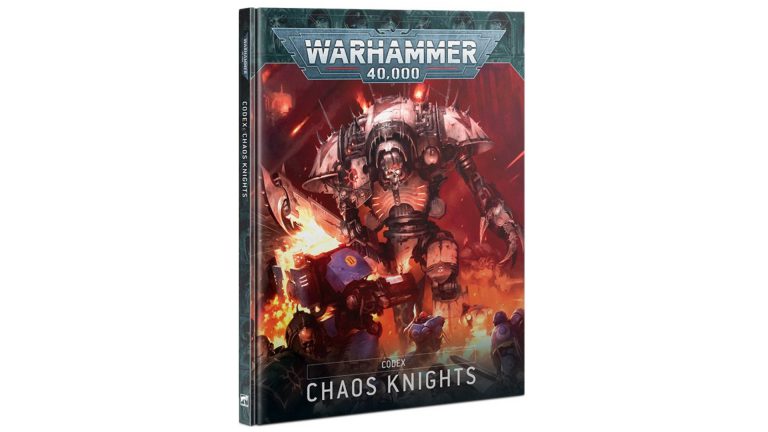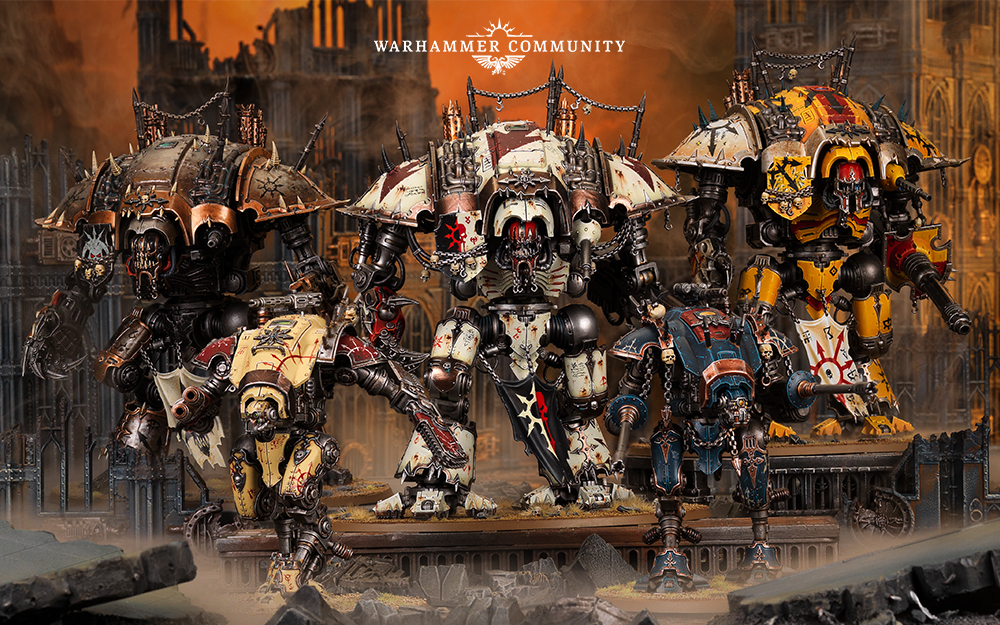
As we continue through our tour of the crusade rules it’s time to take a look at the spooky-stompy bois the chaos knights!
Special Rules:
As you start your crusade you can select one chaos knights to gain damnation points after each battle. As you progress though the eight circles of damnation you can get blessings or damnations. You gain damnation points if you kill enough units (there is a table). It’s an interesting way to assign points and can be a challenge as the table require 4 units killed per battle for Dominus and other non-abhorrant models. Each time you gain 3 points you have to move into the next circle of damnation. Once you reach the 8th circle you can’t progress further but you do gain an RP for every 3 damnation points you achieve. Entering a circle earns you either a pact or a damnation, you don’t get to pick which you get but there are only two damnations in the circles. When it comes to pacts you can choose between greater and lessor pacts. The lesser pacts are aptly named with minor but decent buffs. There are some custom options including one that lowers the number of units you need to kill to gain the damnation point. Unfortunately, the greater pacts are not that much greater. There are some cool options that keep units from deep-striking within 12″. Another good option is one that allows you to re-roll wound rolls of a “1” which is a rare bonus for knights. But some of the other options such as +1 A or +1 to hit in melee are situational depending on the type of knight that you pick. The Exalted pacts are amazing however. All the options are great especially the one that limits you to losing only 6 wounds a turn.
Damnations are limited to just one table. However this table has some very intense options. You know it’s a hard choice when the least-punishing options prevent you from falling back or make you pay an extra CP for any stratagem. Given you need to pick two of these options, it’s a good way to balance out the buffs you will be earning from the pacts.

Agendas and Relics:
You get a choice of 5 different agendas to choose from, though only 4 are worth considering. Dark Vows requires you to select an objective for each chaos knight model in your army. You can gain up to 5 experience for these objectives which vary from killing 10 models a turn, controlling an objective outside your deployment zone or destroying vehicles or monsters. Praise the Dark Gods is an intriguing option that requires you to do an action in the center of the board. While this is a steep cost if you do the action twice every chaos knight units gains 2 experiences points, if done three times you gain 3 experience, if you do it four times you also gain a damnation point for one unit that completed the action (when I play with my knights this will likely be my go-to). Extermination awards bonus exp for tabling the enemy but isn’t really worth it (the previous one is better). Infernal Pact is another good option that makes your opponent create a bonus objective for you to control. If you do then you not only gain 3 experience points you also get to remove 1 battle scar from the unit that completes the action. Lastly, Dread Mercenary is an amazing yet risky agenda. You keep a tally each time the unit kills an enemy unit or hold an objective. If you end the battle with 5 of these points you gain 3 experience points, if you get 10+ you get 5 exp. AND you get a bonus crusade relic, or other requisition for free. This is so amazing and can cause some units to get insanely powerful very quickly, although there are fewer options for vehicle relics. Be warned though, if the knight is destroyed in the battle you lose 5 points and so it may force you to play conservatively.
When it comes to relics the Chaos Knights have more options than their loyalist brethren. In the Artificer slots the Damned Crucible is a must take as it gives you a free minor pact and the ability to get damnation points on a 4+ after each battle. The Throne of Sacrifice is fun in that it doesn’t require you to make an offering to become favored. Finally the Harbinger’s Chains make any dread test taken within dread range an auto-fail if they roll a doubles. For the Antiquity relics you can choose between a Pterrorshades-only relic that subtracts 2 from enemy charge range and inflicts a mortal wound if they fail a charge; or the Icon which allows you to regain D6 wounds once per game. Lastly, the Legendary relic is insanely powerful. Each time you make a wound roll of a 6 (not unmodified 6 mind you) the attack inflicts a number of mortal wounds equal to its damage stat and the sequence ends. This is great for high volume weapons, or knights with many weapon systems.

Army Traits and Requisitions
I will tackle requisitions here first as they are much simpler. You have 6 requisition choices to pick. Dark Infamy gives you a free battle trait or fortitude if you get a knight to 71 exp. Forge A New Destiny also gives you a free lesser pact but for lower leveled units. Path to Damnation allows you to get multiple knights walking the 8 circles. Chosen of the Gods allows you to mark a knight, Dark Favor is how you can get the Favor of the Dark Gods upgrades, though it is only available for a unit walking the eight circles. Finally, Infernal Transfer allows you to swap out knights after a unit gains a Battle Scar, although the only scar that doesn’t carry over is one that is restricted to the knight suit.
There are a bevy of options in the army traits section. You have four tables to choose from: Fallen Noble, Chaos Knight Suit, and Iconoclast/Infernal table. The Fallen Noble table is pretty good with options for extra requisition points (which stacks), the ability to get the character keyword, or get a free re-roll for a hit, wound, advance or charge roll a turn. The Knight Suit table is also quite useful with one fun option allowing you to ignore the limitations on firing blast or heavy weapons in close combat (although you take a mortal wound if you roll a “1” to hit when firing a blast weapon in close combat.) The last two tables are mini 3-option tables with more limited options. There are a few situational choices but few that outshine the other two options.
Finally, you have the battle-scar tables. There are two tables: Knight Pilot scars and Knight Suit scars. For the pilot table there are a few options that aren’t terrible but most are suitably limiting (one of the roughest limits you to a max of 2 exp per battle, but this isn’t bad on a supporting knight). As with the Imperial Knight suit scar table the worst option causes you to reduce your invuln save by 1, some of the options are not quite as bad as the pilot table but some can really limit your agendas.
Conclusion:
Like the Imperial Knight codex the chaos knights have a series of intriguing crusade rules. Overall I think the Chaos Knights have a more engaging and simpler set of rules then their loyalist cousins. It is interesting to see that this codex has built in limitations where the Imperial Knight ones don’t. I think this makes the Chaos Knights easier to incorporate into a campaign, especially considering their agendas.
And remember, Frontline Gaming sells gaming products at a discount, every day in their webcart!



